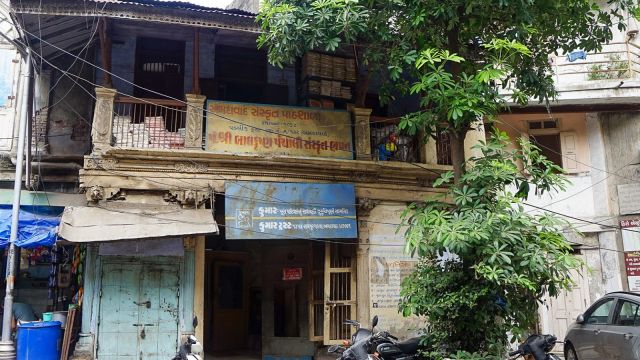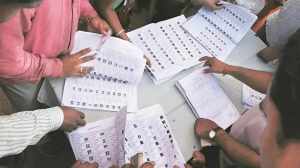Know Your City: ‘Kumar’ magazine turns 100, how it has contributed to art and literature in Gujarat
Renowned artist and journalist Ravi Shankar Raval launched 'Kumar' in 1924 and it is still revered among literary critics
 Kavi Lok, another magazine for poets, is known as a companion of Kumar. Rajendra Patel, who runs the Matrubhasha Abhiyan, which is also associated with Kumar magazine, says the magazine has immensely contributed to literature and art in Gujarat.
Kavi Lok, another magazine for poets, is known as a companion of Kumar. Rajendra Patel, who runs the Matrubhasha Abhiyan, which is also associated with Kumar magazine, says the magazine has immensely contributed to literature and art in Gujarat.Kumar, a magazine considered a pioneer in the pictorial journalism movement in Gujarat, turns 100 this year. Started from a Mumbai-based solicitor’s house in Khadia in the Walled city of Ahmedabad, the monthly cultural magazine maintains its readership legacy even after a century.
For Kapilbhai Ojha, 82, an engineer born and raised in Mumbai, “Kumar is the reason for my entire character and personality, what I am today”. He has been its reader for over 70 years. What started as a magazine for adolescents with pictures and paintings, Kumar has immensely contributed to literature and art in Gujarat and is still revered among literary critics.
When launched in 1924 by renowned artist and journalist Ravi Shankar Raval, one issue would cost an anna, and today it is Rs 50, though an annual subscription is Rs 500. From the house of Mumbai solicitor Bhai Shankarbhai Purohit’s house in Bauva ni pol near Raipur police chowki in Ahmedabad’s walled city area of Khadia, Kumar has witnessed it all from pre-independence, closure by the British government to currently the era of digital journalism.
 Prafull Raval, editor of Kumar was associated with Kumar from 2001 to 2021 as a sub-editor. Following his predecessor Dhirubhai Parikh’s death due to Covid on May 9, 2021, he was appointed as the editor.
Prafull Raval, editor of Kumar was associated with Kumar from 2001 to 2021 as a sub-editor. Following his predecessor Dhirubhai Parikh’s death due to Covid on May 9, 2021, he was appointed as the editor.
“With 1,000 subscriptions at present, even today, we have a majority of our readers as senior citizens who have been ardently following Kumar for decades. Among the remaining 50 per cent, 25 per cent are the libraries, schools and colleges, and the other 25 per cent of readers are 25-35 years old. The readership has also transitioned from prosperous people initially to educated Brahmin, Baniya and later Patels and Kshatriyas,” Prafull Raval, editor of Kumar, told The Indian Express.
Raval was associated with Kumar from 2001 to 2021 as a sub-editor. Following his predecessor Dhirubhai Parikh’s death due to Covid on May 9, 2021, he was appointed as the editor.
The late Ravishankar Raval, painter, art teacher, art critic and journalist, founded Kumar after the magazine Vismi Sadi he worked with closed down in 1921. Ravishankar Raval founded Kumar for students, to whom he would teach drawing and art without any cost. He started this magazine with Bachubhai Rawat and poet Deshalji Parmar, both from Gondal. The three together thought of bringing a magazine for adolescents who should widen their horizons and should be pictorial.
“For one year, the monthly magazine was printed by Navjivan Press, which, too, was in the walled city at that time. Later, with the realisation of having our own press at the same building, a fixed monthly magazine format with painting on the cover page started from the second year,” said Raval.
With time, a structure got formalised. Also, during the Satyagraha in the 1930s, when Ramprasad Shukla and the like would visit Ahmedabad, they get together and meet over tea and Raipur bhajiya and even sleep at Kumar Karyalaya- the office of the magazine. Over time, Bachubhai and Umashankar decided to start a Sabha for poets. Wednesday was fixed as Rabindranath Tagore’s Shantiniketan was closed on Wednesdays. Thus, poets nationwide would participate in the Buddhvariyu from 7-8 pm.
 The late Ravishankar Raval, painter, art teacher, art critic and journalist, founded Kumar after the magazine Vismi Sadi he worked with closed down in 1921.
The late Ravishankar Raval, painter, art teacher, art critic and journalist, founded Kumar after the magazine Vismi Sadi he worked with closed down in 1921.
Prakash N Shah, former president of Gujarati Sahitya Parishad, says Kumar is also known for the kavi baithak. “Bachubhai Rawat, from 1924 to 1978, until his demise, devoted his life to promoting Kumar magazine, which is also popular for the weekly sabha for poets called Buddhvariyu, every Wednesday.
Bachubhai would read works of poets as opening lines, followed by discussions among the participants. This tradition became a landmark in Gujarat, also termed an informal school for poets. At Bachubhai’s request, the Buddhvariyu was taken over by the Gujarati Sahitya Parishad, now known as Buddh Sabha. Kumar is also instrumental in printing the Ashram life of Mahatma Gandhi in South Africa.”
Kavi Lok, another magazine for poets, is known as a companion of Kumar. Rajendra Patel, who runs the Matrubhasha Abhiyan, which is also associated with Kumar magazine, says the magazine has immensely contributed to literature and art in Gujarat.
 Prakash N Shah, former president of Gujarati Sahitya Parishad, says Kumar is also known for the kavi baithak.
Prakash N Shah, former president of Gujarati Sahitya Parishad, says Kumar is also known for the kavi baithak.
Prafull Raval says another offshoot of Kumar for photographers was born when a retired colonel, Balwant Bhatt, visited Kumar Karyalaya and decided to run free photography classes.
From there, a camera club named Niharika started, and it still exists. At that time some of the good photos in the black-and-white era were published in Kumar.
Debashish Nayak, heritage adviser in Gujarat Vidyapith, says Kumar holds a revered status in Gujarat as one of India’s finest periodicals, akin to Shri Rabindranath Tagore’s Shantiniketan.
“This organisation has nurtured some of Gujarat’s most exceptional poets, painters, photographers, and art enthusiasts. It has established itself as a unique institution dedicated to fostering emerging talent across various disciplines,” Nayak adds.
 Debashish Nayak, heritage adviser in Gujarat Vidyapith, says Kumar holds a revered status in Gujarat as one of India’s finest periodicals, akin to Shri Rabindranath Tagore’s Shantiniketan.
Debashish Nayak, heritage adviser in Gujarat Vidyapith, says Kumar holds a revered status in Gujarat as one of India’s finest periodicals, akin to Shri Rabindranath Tagore’s Shantiniketan.
Recalling the time when the magazine had to be discounted briefly, Prafull Raval says, “In 1932, after a play on the nation’s independence was published, the government confiscated the magazines and closed down the press. The edition was stalled for a month.
Again, in 1987-90, Kumar was closed due to financial constraints as the trustees were unable to pay the bank loans, which kept on adding. However, with people’s support, the magazine started again and never looked back.
Revenues and profits were never Kumar’s priority. Even today, the building, Kumar Karyalaya, is rented. The initial rent of Rs 8 per month increased to Rs 10, then to Rs 15, and currently stands at Rs 1,500-2,000 for 12 months.
“Kumar was the foundation of our generation which one can never find in mobiles today. Today’s generation is smart but without a foundation and thus like a hollow structure. However our generation was not smart but with immense depth of knowledge,” Kapilbhai Ojha, who is now settled in Ahmedabad, tells The Indian Express.
Raval shared his plans for Kumar, stating, “My goal is to increase the readership among 25-35-year-olds from the current 25 per cent to its maximum potential. I plan to achieve this by featuring new, younger talent that will inspire others to read Kumar and extend its reach to at least ten readers in every village.”
However, the printing press has been closed since the late 1990s. The magazine is printed outside while the pages are designed on a computer. Kumar might adapt to technological advancements. Though we are not economically sound enough to venture into the online space, we will think of an online edition, too, as we want to reach out to the younger generation.







